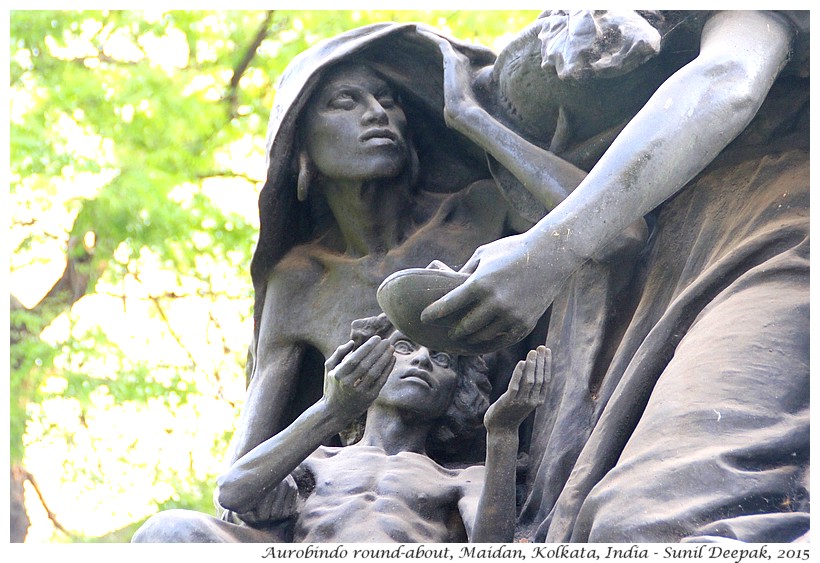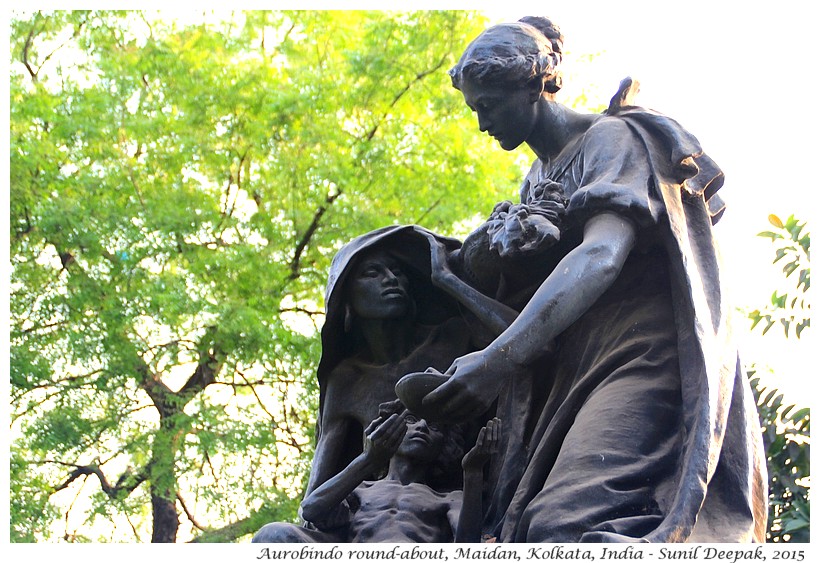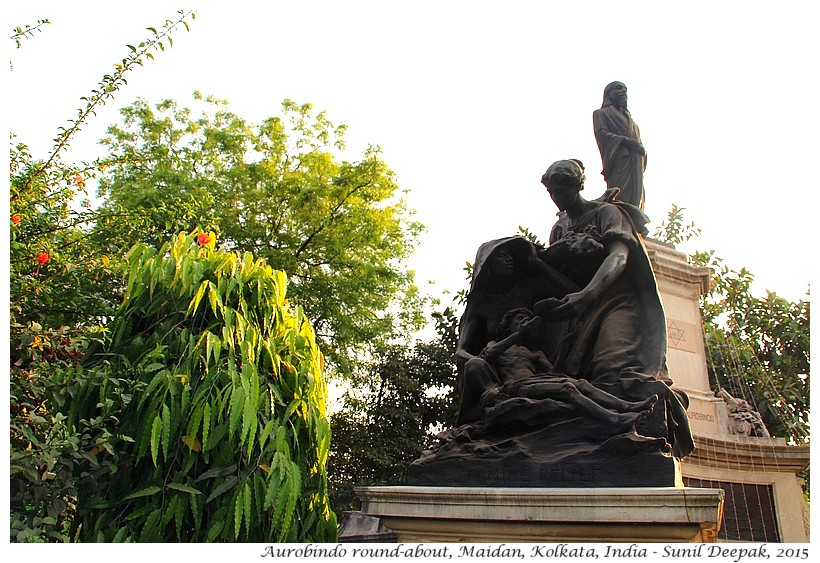


Kolkata, India: During the second world war, in 1943 there was another holocaust in north-eastern India when about 3 million persons died due to hunger. This episode has been almost forgotten and few persons in India remember it. Near the famous Victoria Memorial of Kolkata, near the statue of Sri Aurobindo, when I saw the statue of a poor hungry child, I thought about it. In the statue, a woman representing the British empire is shown giving food to the boy. Here in the place of Sr Aurobindo, once there was the statue of Lord Curzon. I thought that it was an irony of the history that the British empire responsible for those millions of deaths is shown as the helper of poor.
कोलकाता, भारतः दूसरे महायुद्ध के दौरान 1943 में उत्तर पूर्वी भारत में बड़ा नरसंहार हुआ, भुखमरी से करीब 30 लाख लोगों की मृत्यू हुई, उनके बारे में इतिहास भूल गया और आज भारत में थोड़े लोगों को इसकी याद है. कोलकाता के प्रसिद्ध विक्टोरिया मेमोरियल के सामने जहाँ श्री ओरोबिन्दो की मूर्ति लगी है, उसके पास एक दरिद्र भूखे बच्चे की मूर्ति को देख कर यह बात याद आ गयी. भूखे बच्चे की इस मूर्ति में उसे खाना देनी वाली एक अंग्रेज़ युवती है जो ब्रिटिश राज्य का प्रतीक है. यहाँ कभी ओरोबिन्दो की जगह लार्ड कर्ज़न की मूर्ति होती थी. मुझे लगा कि यही इतिहास का व्यंग है कि भुखमरी और लाखों लोगों के मारने का जिम्मेदार ब्रिटिश शासन, मूर्ति में गरीबों की सहायता करने वाला दिखाया गया है.
Calcutta, India: Durante la seconda guerra mondiale, nel 1943 vi era un olocausto anche nell'India nord-orientale quando circa 3 milioni di persone morirono per fame. Questo episodio è quasi dimenticato e pochi in India lo ricordano. Vicina alla famosa Victoria Memorial di Calcutta, vicino la statua di Sri Aurobindo, quando ho visto la statua del bambino affamato, l'ho pensato. Nella statua una donna che rappresenta l'impero inglese dà da mangiare al bambino. Qui al posto di Sri Aurobindo, una volta c'era la statua di Lord Curzon. Pensavo che era un'ironia della storia che l'impero inglese responsabile di quelli 3 milioni di morti è presentato come quelli che aiutavano i poveri.
***
Infact it is not irony. The British systematically broke the backbone of the farmers. Steep levy of taxes and if not paid led to auction of landed properties. The wonderful irrigation system prevalent in India before the british raj, went into ruins due to lack of maintenance. Even books written by Britishers in the 1800s talk about such irrigation systems. Overall it led to the farming community brought down to their knees. The Great famine in 1943 was an entirely man-made event where 30 lakh (3 million) people died due to starvation. At that time Bengal was undevided and comprised west bengal and the Bangladesh of today.
ReplyDeleteThe British hoarded the rice fearing attacks from the Japanese. The price of rice had shot up 4-5 times. People didn't have anything to eat. And to top it, Sir Winston Churchill, hated India to the core of his heart. He neither accepted food grains from US, nor took steps to tackle the situation. It is said that when he was informed about the famine he had sarcastically commented that "Indians breed like rabbits". If this would have happened today, perhaps Churchill would have been tried for War Crimes. Amartya Sen's book is also worth reading.
I agree Sabyasachi. I find it a shame that all those deaths, that were equally indicting of the British empire as those who had killed millions systematically in the concentration camps, have not been examined more by Indian writers, philosophers, film makers so that as a country we can learn from that experience.
DeleteSuch a holocaust. It's a shame when someone dies out of hunger... The volume here was too huge to fathom though. The statue is really a great depiction of a huge majority in our country still.
ReplyDeleteThere are some testimonies, but nothing that looks at the experience of that famine in depth, no films have been made about it, there are no popular books explaining the death of those millions. It is difficult to imagine 3 million persons dying in a few months and the kind of impact it must have had on peoples' lives and imagination.
DeleteThanks Lancelot.
सोचने पर मजबूर कर देने वाली कृति. आपकी इस उत्कृष्ट रचना का उल्लेख कल सोमवार (30-03-2015) की चर्चा "चित्तचोर बने, चित्रचोर नहीं" (चर्चा - 1933) पर भी होगा.
ReplyDeleteसूचनार्थ
सराहना के लिए तथा चर्चामंच पर जगह देने के लिए धन्यवाद अनूषा जी
Delete